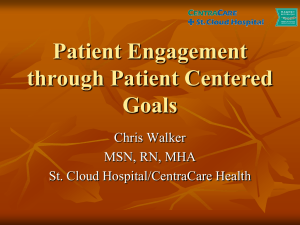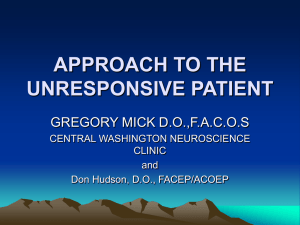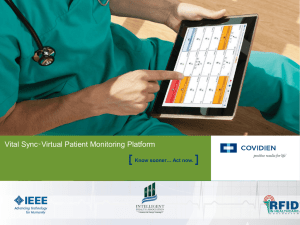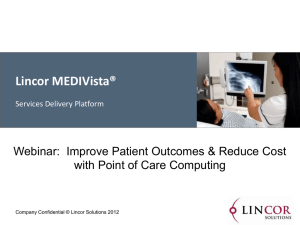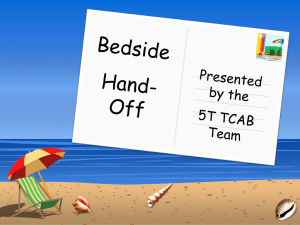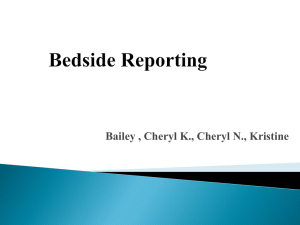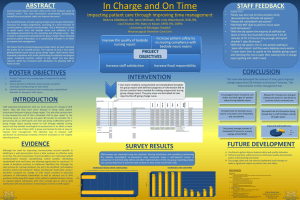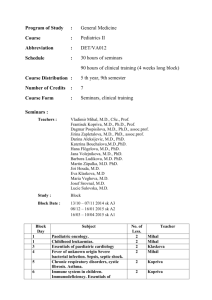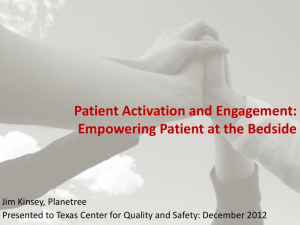Bedside monitoring What is monitored?
advertisement
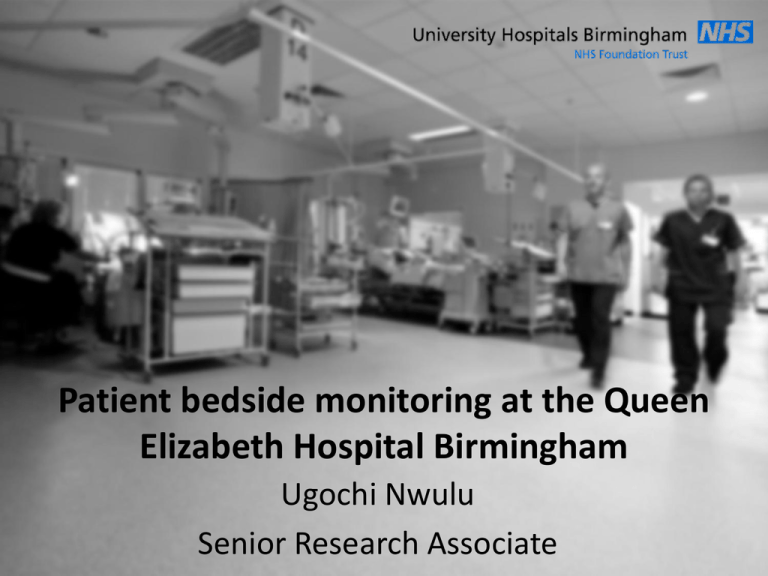
Patient bedside monitoring at the Queen Elizabeth Hospital Birmingham Ugochi Nwulu Senior Research Associate Birmingham and Black Country CLAHRC Theme 9: Improving Patient Safety – Studying an evolving IT system This theme evaluates the implementation of various clinical computing technologies in University Hospital Birmingham NHS Foundation Trust that aim to improve safety and quality of care Outline of presentation Bedside monitoring: What, When, Who and Why Interventions which improve patient outcomes: by improving patient bedside monitoring What happens at UHB: an overview of PICS and the electronic observation form Bedside monitoring in the future: advanced computerised solutions Bedside monitoring What is monitored? • TPR charts: temperature, pulse, respiratory rate, blood pressure & oxygen saturation most frequent measurements taken by health care professionals • These VITAL SIGNS are important indicators of the body’s response to stressors and form part of a routine physical assessment • Additionally – measures of consciousness (AVPU), urine output, pain scores are part of bedside monitoring • Other aspects of bedside monitoring are often needed in different circumstances – after certain procedures Bedside monitoring When to monitor? • • • • • On admission According to ward/unit/specialty Before and after a procedure/surgery Before and after blood transfusions As indicated with medications ALSO! Changes in patient's physical condition i.e. pain Patient in distress or family reports a change Intuition/clinical experience NICE guidance recommends that all inpatients must have their vital signs recorded as a minimum every 12 hours but the frequency should be increased when abnormal physiology is detected. Acutely ill patients in hospital: recognition of and response to acute illness of adults in hospital.CG50 National Institute for Health and Clinical Excellence 2007. Bedside monitoring Who monitors? • Observations are usually taken by nursing staff – both registered and non registered. • Can often be delegated to more junior or less experienced members of the team Important that staff are aware of the significance of vital sign recording, and have the knowledge and skill to interpret them to ensure patient safety Safer Care for the Acutely Ill Patient: Learning from Serious Incidents. National Patient Safety Agency 2007 Bedside monitoring Why is it important? • Important to provide baseline set of vital signs to identify subsequent changes in a patient’s condition • Critical events (cardiac arrests, deaths & unplanned ICU transfers) are often preceded by physiological deterioration (and often signs of physiological deterioration!) Bedside monitoring can be perceived as basic and routine BUT plays a vital role to ensure safer patient care and early recognition of deterioration. Reducing harm from deterioration Record vital signs Staff Education Recognition Monitoring Competence in recording/ understanding physiological observations *adopted from the Chain of Prevention © Gary Smith Call for help Response Interventions to improve patient outcomes Response strategy Critical Care Outreach Medical Emergency Teams Staff Education Recognition Monitoring Call for help Escalation protocol *adopted from the Chain of Prevention © Gary Smith Response Communication tool Interventions to improve patient outcomes “Track and trigger” systems •Used on paper-based and electronic observation charts •Periodic observation of selected vital signs (the “tracking”) with pre-determined criteria (the “trigger”) for requesting the attendance of more experienced staff The Early Warning Score System HR 3 2 1 0 1 2 3 <30 30-39 40-49 50-99 100-109 110-129 ≥130 70-79 80-99 100-199 85-89 90-92 ≥93 sBP O2 Sats <85 RR <9 TEMP <34 CNS 34 35 ≥200 9-20 20-30 31-35 36-37 >38 ≥39 A V P ≥36 U Interventions to improve patient outcomes (2)... An Early Warning Score Staff Education Recognition Monitoring Call for help *adopted from the Chain of Prevention © Gary Smith Response The use of PICS in the Trust PICS is the Trust’s locally developed electronic prescribing solution that is available on every computer desktop in the Trust PICS is a rules based system for managing clinical investigations, prescribing and drug administration PICS also has Paperless management of drug therapy/protocols Discharge letters/summaries Results reporting Order communications Automated lab requesting Electronic observation form Real-time, event driven alerts Bed state, dependencies, estimated length of stay Clinical procedures Clinical notes A change in prescribing - From this to this using this A change in vital signs recording From this To this Using this 2007: Development of electronic form 2009: Go-live in May. Pilot ward was Burns and Plastics 2012: Now in majority of wards Electronic observation form Education Recognition Monitoring Alerts to doctors and nurses based on severity of SEWS *adopted from the Chain of Prevention © Gary Smith Response Ready access to electronic data capture Call for help Emails to Critical Care Outreach What next for bedside monitoring? Coming soon - a National Early Warning Score (NEWS) Advanced computerised solutions Coming soonish - Wireless Vital Signs Monitor* The monitor tracks a patient’s HR and RR by beaming Doppler radar technology into their chest. It uses radio frequency electromagnetic waves reflected from the body's surface and only requires that the white device face the patient to work. * Kaiser Permanente's Garfield Health Care Innovation Centre Advanced computerised solutions (2) Coming when? Body Sensors and Smart Phones to Implantable Biodegradable Sensors* ViSi Mobile® by Sotera Wireless *GE Wireless Communication (http://www.nanotechgalaxy.com) Continuous vital signs monitoring: a wristworn device that measures HR/PR, 3- or 5lead electrocardiography (ECG), SpO2, BP, RR and skin temperature through body sensors Research opportunities... Thank you! For further information about Theme 9 please contact: Principal investigator: Dr Jamie Coleman, jamie.coleman@uhb.nhs.uk Project manager: Miss Ugochi Nwulu, ugochi.nwulu@uhb.nhs.uk
